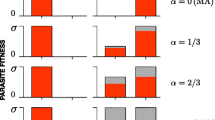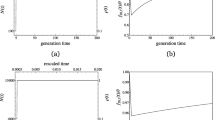Summary
Host—parasite interactions often have complex dynamics. At the level of individual allele frequencies, the dynamics are difficult to predict and difficult to measure. However, aggregate properties of polymorphism, such as allelic diversity or the frequency of resistance, may be relatively easy to work with. I study this problem with computer simulations of a host—parasite model. In one example, the simulations show that the allelic diversity at a locus is similar in a host—parasite model and a neutral model in which drift is the only evolutionary process. Allelic diversity is similar in the two models, even though the temporal dynamics of individual allele frequencies are very different. In a second example, the genetic system that would be inferred from analysing samples of hosts and parasites is quite different from the actual specificity that determines the dynamics of the system. Thus, general conclusions about the specificity of host—parasite genetics must be analysed in the context of the expected statistical distributions of polymorphism. The final example shows that the frequency of resistance provides an interesting aggregate measure of host—parasite polymorphism. If the ratio of parasite generation time to the time between the reproductive seasons of the hosts is small, then no regular periodicity in the frequency of resistance occurs. However, if parasites have many generations per reproductive season of the host, then resistance fluctuates with a period equal to the seasonality of the host. The important role of seasonality shown here differs from the emphasis in previous theories on the relative generation times of host and parasite.
Similar content being viewed by others
References
Bevan, J.R., Crute, I.R. and Clarke, D.D. (1993a) Variation for virulence inErysiphe fischeri fromSenecio vulgaris.Plant Pathol. 42, 622–35.
Bevan, J.R., Clarke, D.D. and Crute, I.R. (1993b) Resistance toErysiphe fischeri in two populations ofSenecio vulgaris.Plant Pathol. 42, 636–46.
Burdon, J.J. (1987)Diseases and Plant Population Biology. Cambridge University Press, Cambridge.
Flor, H.H. (1955) Host—Parasite interaction in flax rust—its genetics and other implications.Phytopathology 45, 680–85.
Flor, H.H. (1971) Current status of the gene-for-gene concept.Ann. Rev. Phytopathol. 9, 275–96.
Frank, S.A. (1993) Specificity versus detectable polymorphism in host—parasite genetics.Proc. R. Soc. Lond. B 254, 191–7.
Frank, S.A. (1994) Recognition and polymorphism in host—parasite genetics.Phil. Trans. R. Soc. Lond. B 346, 283–93.
Hamilton, W.D. (1980) Sex versus non-sex versus parasite.Oikos 35, 282–90.
Hamilton, W.D. (1993) Haploid dynamic polymorphism in a host with matching parasites: effects of mutation/subdivision, linkage, and patterns of selection.J. Heredity 84, 328–38.
Hamilton, W.D., Axelrod, R. and Tanese, R. (1990) Sexual reproduction as an adaptation to resist parasites (a review).Proc. Natl Acad. Sci. USA 87, 3566–73.
Magurran, A.E. (1988)Ecological Diversity and its Measurement. Princeton University Press, Princeton.
May, R.M. (1986) When two and two do not make four: nonlinear phenomena in ecology.Proc. R. Soc. Lond. B 228, 241–66.
Parker, M.A. (1994) Pathogens and sex in plants.Evol. Ecol. 8, 560–84.
Weir, B.S. (1990)Genetic Data Analysis. Sinauer Associates, Sunderland, MA.
Author information
Authors and Affiliations
Rights and permissions
About this article
Cite this article
Frank, S.A. Statistical properties of polymorphism in host—parasite genetics. Evol Ecol 10, 307–317 (1996). https://doi.org/10.1007/BF01237687
Issue Date:
DOI: https://doi.org/10.1007/BF01237687




